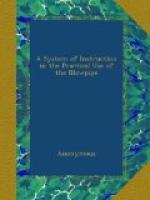Mineral. Scorodite
Formula. [...Fe=][.....As] + 4[.H].
Behavior
(1) in glass-bulb. Evolves water.
(2) in open tube. Gives off water and AsO^{3}.
(3) on charcoal. Emits arsenical
fume and in the reducing flame
fuses
to a magnetic mass having a metallic
lustre.
(4) in forceps. I. As on charcoal.
Colors the outer flame
blue.
(5) in borax. The roasted mineral gives an iron reaction.
(6) in mic. salt. As in borax.
(7) with carb. soda. As alone on charcoal.
(8) Special reactions. Gives the arsenic reactions.
* * * * *
Mineral. Cube ore
Formula. [.Fe]^{3}[.....As] +
[...Fe=]^{3}[.....As]^{2} + 18[.H].
Behavior
(1) in glass-bulb. Evolves much water.
(2) in open tube. As the preceding.
(3) on charcoal. As the preceding.
(4) in forceps. As the preceding.
(5) in borax. As the preceding.
(6) in mic. salt. As in borax.
(7) with carb. soda. As the preceding.
(8) Special reactions. As the preceding.
* * * * *
MANGANESE.
* * * * *
Mineral. Manganblende
Formula. MnS.
Behavior
(1) in glass-bulb. —
(2) in open tube. Gives off
SO^{2} and becomes greyish green on
surface.
(3) on charcoal. Is slowly roasted and converted into oxide.
(4) in forceps. V.
(5) in borax. The roasted
mineral gives a strong manganese
reaction.
(6) in mic. salt. In the unroasted
state, dissolves with much
ebullition
and detonation due to elimination of
sulphide
of phosphorus. The bead then exhibits
the
characteristic violet color of manganese.
(7) with carb. soda. Forms a slaggy
mass, which laid on silver and
moistened,
gives the sulphur reaction.
(8) Special reactions. —
* * * * *
Mineral. Pyrolusite
Formula. [..Mn].
Behavior
(1) in glass-bulb. Frequently
gives off a small quantity of water
and,
when strongly heated, oxygen.
(2) in open tube. —
(3) on charcoal. —
(4) in forceps. V.




